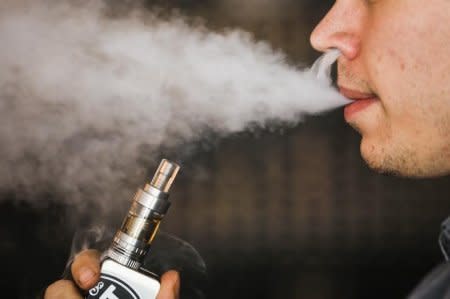Vaping tied to higher risk that teens will try marijuana

Thomson Reuters
By Lisa Rapaport
(Reuters Health) - Teens who use e-cigarettes may be twice as likely to smoke pot as their peers who never try vaping, a U.S. study suggests.
The results, from surveys of more than 10,000 youth ages 12 to 17, add to earlier evidence suggesting that e-cigarettes may be a gateway to smoking tobacco and experimenting with drugs. In the current study, younger teens aged 12 to 14 were 2.7 times more likely to smoke pot once they tried vaping, while the odds of marijuana use were 1.6 times higher for older adolescents who used e-cigarettes.
While the study wasn’t designed to prove whether or how vaping might directly lead to marijuana use, it’s easy to see how one bad habit might lead to another, said lead study author Hongying Dai of Children’s Mercy Hospital and the University of Missouri-Kansas City.
"The brain is still developing during the teen years, nicotine exposure might lead to changes in the central nervous system that predispose teens to dependence on other drugs of abuse," Dai said by email.
"Experimenting with e-cigarettes might also increase youth’s curiosity about marijuana, reduce perceived harm of marijuana use, and increase the social access to marijuana from peers and friends," Dai added.
Dai's team surveyed teens twice, one year apart. Among youth who didn't use marijuana at the start of the study, 27 percent who admitted using e-cigarettes had moved on to pot one year later, compared to only 8 percent of those who hadn't tried vaping.
Heavy marijuana use was also more common among the youth who had tried e-cigarettes, researchers report in Pediatrics.
E-cigarettes are battery-powered devices that feature a glowing tip and a heating element that turns liquid nicotine and other flavorings into a cloud of vapor that users inhale.
One concern with the link between e-cigarettes and marijuana use is that teens might use the devices to vape marijuana, which could lead them to become addicted to a stronger and more potent form of marijuana, Dai said.
A separate study in Pediatrics highlights another unintended risk of e-cigarettes – that young children might drink the liquid nicotine used in the devices. Nicotine is much more concentrated in e-liquids than it is in traditional cigarettes, and it can also be sweetened with flavors like strawberry, vanilla, and chocolate that may smell and taste appealing to young kids.
Poisonings among kids under six years old surged from 2012 to 2015, when more than 10 children in every 100,000 in the population ingested liquid nicotine, the study found.
Then amid tighter regulations requiring tamper resistant liquid nicotine packaging, poisonings became less common among young kids from 2015 to 2016, when slightly more than 8 kids in every 100,0000 ingested liquid nicotine.
"Although the observed decrease in exposures is encouraging, the number of young children still being exposed to liquid nicotine is unacceptably high," said senior study author Dr. Gary Smith, director of the Center for Injury Research and Policy at Nationwide Children’s Hospital in Columbus, Ohio.
Most of these poisonings happened in kids under three years old, the study found.
Not all children are seriously harmed, but drinking liquid nicotine can sometimes cause serious complications like seizures and comas, or even prove fatal.
"A single swallow of the concentrated liquid nicotine used in e-cigarettes could easily result in a lethal dose to a young child," Smith said by email. "Liquid nicotine and e-cigarettes pose a greater poisoning risk than traditional cigarettes."
SOURCE: http://bit.ly/2HWM1q8 and http://bit.ly/2HSMwSa Pediatrics, online April 23, 2018.
See Also:

 Yahoo News
Yahoo News 
